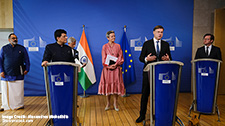Managing Connectivity Conflict: EU-India Cooperation and China’s Belt and Road Initiative

Jagannath P. Panda and Maaike Okano-Heijmans
Executive Summary
Connectivity initiatives are the latest geopolitical tool for advancing influence in international relations and diplomacy. Against the backdrop of an emerging connectivity conflict, the responsibility is on likeminded countries and organizations to promote initiatives that embody transparency and universalism in connectivity projects and that benefit citizens in the long term. The EU and India are two important actors in this regard.
This paper analyzes the scope of cooperation in the field of connectivity between the EU and India, arguing that they are two important strategic poles of the current world order with shared interests. Europe and India are key actors of the western and non-western democratic liberal, both aiming to strengthen an “open, transparent and rules-based system of international politics and economics.” Realizing this potential requires candid and engaged strategic and economic exchange between the two sides. Responding to the need for both hard and soft infrastructure systems, many governments have factored connectivity as the lynchpin of their foreign policy. China’s Belt and Road Initiative (BRI) is only one of these, but it is the most developed of these initiatives by far. It could become the arch of the 21st-century world order. What is clear, is that this Chinese initiative challenges the current open and transparent rules-based system of international politics and economics advanced in the 20th century. Seen as a “manifestation of China’s re-globalization ambitions,” the BRI raises expectations of economic and political opportunities at one level while inviting skepticism and doubt over its operational mode at another.
Set against this context, the United States, Japan, India, Australia and the European Union (EU) have started their own counter-initiatives to balance the Chinese outreach under the BRI.
By and large, these “likeminded” actors are yet to add real projects and funds to their proposed initiatives. Also lacking is a consensus on how to interrelate their connectivity propositions, which now largely run parallel at best and cross-purpose at worst. Obviously, there is dearth of substantive engagement about one another’s strategic thought. The Trump administration’s approach towards likeminded countries and its noncommittal approach towards Asia on global trade multilateralism have certainly not helped matters.
The EU and India are particularly affected by the ambitions of China’s BRI, as the PRC is enhancing its political and strategic influence in Europe and around India’s neighborhood. This provides strategic momentum and political imperative for the two sides to bind forces and promote sustainable connectivity as their overarching connectivity narrative. That means commercially viable and transparent, guaranteeing a level-playing field for businesses, a respect of labor rights and environmental standards, and avoiding financial dependencies. To deliver on-the-ground results, the EU and India can draw lessons from the Asia-Africa Growth Corridor (AAGC) as the approach to concrete projects. What should also be taken from the AAGC is its strength in adding interregional focus, explicating where the partners complement each other.
Related Publications
-
ISDP Annual Report 2023
ISDP’s Annual Report for the year 2023. We look back on 2023, a year in which tensions and conflicts captured the strategic space in ISDP’s focus areas, making headlines around […]
-
Trade, Connectivity and Supply Chains in EU-India Relations
In the decade and a half since 2007 when the EU and India first started their FTA negotiations, the world economic order has undergone a sea change. During that period, […]
-
The Political Split at the Heart of Taiwan’s Struggle against Foreign Disinformation
Taiwan’s struggle against foreign disinformation and concerns about China’s impact on its 2024 election has received much international attention recently. This issue brief examines the domestic and international politics behind […]
-
IN DEFENSE OF THE LIBERAL INTERNATIONAL ORDER
In recent years, the geopolitical fight for global economic, diplomatic, and institutional control has acutely intensified, accentuating the crisis in the existing post-World War II Liberal International Order (LIO), championed […]
-
China in Eurasia: Revisiting BRI amidst the Russia-Ukraine Crisis
This paper discusses China’s trade and connectivity plans under the Belt and Road Initiative (BRI) in the Eurasian region and the impact of the Russian invasion of Ukraine on Chinese […]




